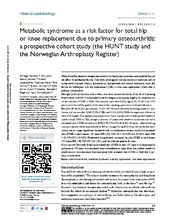| dc.Published | Hellevik AI, Johnsen MB, Langhammer A, Baste V, Furnes O, Storheim K, Zwart J, Flugsrud GB, Nordsletten L. Metabolic syndrome as a risk factor for total hip or knee replacement due to primary osteoarthritis: A prospective cohort study (the HUNT study and the Norwegian arthroplasty register). Clinical Epidemiology. 2018;10:83-96 | eng |
| dc.description.abstract | Objective: Biochemical changes associated with obesity may accelerate osteoarthritis beyond the effect of mechanical factors. This study investigated whether metabolic syndrome and its components (visceral obesity, hypertension, dyslipidemia and insulin resistance) were risk factors for subsequent total hip replacement (THR) or total knee replacement (TKR) due to primary osteoarthritis. Design: In this prospective cohort study, data from the second survey of the Nord-Trøndelag Health Study 2 (HUNT2) were linked to the Norwegian Arthroplasty Register for identification of the outcome of THR or TKR. The analyses were stratified by age (<50, 50–69.9 and ≥70 years) and adjusted for gender, body mass index, smoking, physical activity and education. Results: Of the 62,661 participants, 12,593 (20.1%) were identified as having metabolic syndrome, and we recorded 1,840 (2.9%) THRs and 1,111 (1.8%) TKRs during a mean follow-up time of 15.4 years. Cox regression analyses did not show any association between full metabolic syndrome and THR or TKR, except in persons <50 years with metabolic syndrome who had a decreased risk of THR (hazard ratio [HR] 0.58, 95% CI 0.40–0.83). However, when including only participants whose exposure status did not change during follow-up, this protective association was no longer significant. Increased waist circumference was associated with increased risk of TKR in participants <50 years (HR 1.62, 95% CI 1.10–2.39) and 50–69.9 years (HR 1.43, 95% CI 1.14–1.80). Hypertension significantly increased the risk of TKR in participants <50 years (HR 1.38, 95% CI 1.05–1.81), and this risk was greater for men. Conclusion: This study found an increased risk of TKR in men <50 years with hypertension and persons <70 years with increased waist circumference. Apart from this, neither metabolic syndrome nor its components were associated with increased risk of THR or TKR due to primary osteoarthritis. | en_US |

